Risk Management and Trade Criteria– Crypto Academy / S5W7- Homework Post for @reminiscence01
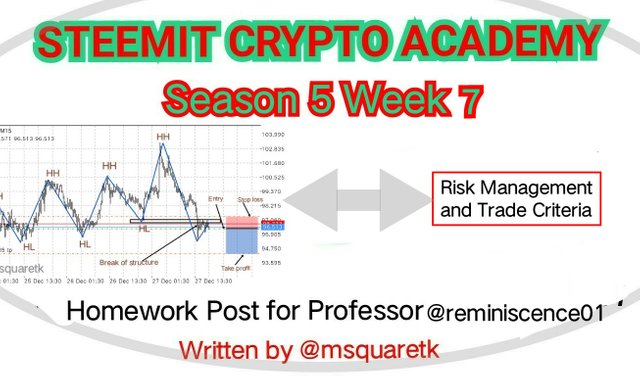
Cover page Created by me, @msquaretk | created with imarkup App
It's a new week in the Steemit Crypto Academy. This is week seven (7) of the season 5 in the Academy. To all Professors who have been sacrificing their time and energy to put the lectures together, the steem curators curating the homework posts, and the entire management of the Steemit Crypto Academy, thank you.
This post is written in response to Professor @reminiscence01's assignment after his lecture on "Risk Management and Trade Criteria". He taught the topic very well by explaining what it means, the importance of risk management and the tools which we can use to manage the risk. I will be responding to the questions given one after the other. Follow me closely.

1. What do you understand by "Risk Management"? What is the importance of risk management in Crypto Trading?.

What do you understand by "Risk Management
One of the most important aspects of trading is learning to manage risk. Many traders have learnt different trading strategies and have even developed their own strategies themselves. Many still end up losing their funds, and get frustrated. The thing is that, it is not that the strategies they are using aren't not working. Most of the times, it's because they have not really learnt to manage risk very well.
I remember in the year 2019 when I first started trading live account after undergoing a training. I funded my account with $100 then. I was so curious, I wanted to make money. I wasn't patient, didn't set any rules and have no knowledge of risk management very well. I opened too many positions and ended up blowing my entire capital in a day. As I kept losing, I kept thinking I would make it back until no money in the account. So, without proper knowledge of risk management, traders will always get frustrated.
Risk management in trading involves the various activities done, use of tools to prioritize, control and monitor trading so as to minimize loss and maximize profit. It's pertinent to know that loss is inevitable in trading and that traders must prepare for it. So, risk management is a way to prepare for this. There are many tools used by traders to manage risk such as devising percentage they will be using to take a position in the market (Most traders use 1% – 1% rule), deciding the exit criteria, stop loss and take profit (risk reward ratio) etc. I will talk more on these tools later.
In essence, risk management is a way of planning trade using every tools possible to minimize loss and maximize profit. Risk management is a big course which every trader must learn early if they will experience a smooth journey in trading. When they learn to manage risk, they will know how to manage their trading capital and thereby minimize loss and maximize profit which is often the goal of every trader. But they can't achieve the goal until they learn risk management.
What is the importance of risk management in Crypto Trading
Like I said above, winning strategy is not a substitute for risk management. You may have the best strategy in the world of trading and still end up not able to manage your trading capital or fund. So, risk management helps traders in the management of trading capital. When you employ risk management with your strategy, your account will be protected.
In addition, risk management enables the traders to minimize loss and maximize profit. By planning and taking some important tools to manage the risk, you are actually trying to reduce the loss. And when the loss is reduced, the profit should increase. For example, if you take a decision to using a risk reward of at least 1:2 on every position you take in the market, you have made your profit to be more than the loss.
Further, it improves traders' emotion and boost confidence. By using risk management, traders will set the rules and will be abiding with the rules set. If a trade goes against him, since he hasn't used more fund on a position, he will be worried less and thereby managing his emotion and increasing the confidence.
It brings about organization. When you see traders who have learnt risk management and incorporated it into their trade, they are very organized. This is because they have planned when to trade, and when not to. They don't chase the market up and down. They wait for the criteria to be met and enter when they see signals.

2. Explain the following Risk Management tools and give an illustrative example of each of them. (a) 1% Rule. (b) Risk-reward ratio. (c) Stoploss and take profit

In this part of the task, I am going to be explaining various risk management tools. Let's be begin with the first one.
(a) 1% Rule
1 percent rule is one of the popular tools which traders are often encouraged to use to protect their trading capital. Remember my experience I shared above of how I blew my trading capital the day I started trading live account. I wasn't used any 1% rule because I was taught properly. If I had used one percent rule on a $100 trading capital, I would not blow that account in a day.
The rule means, using only 1% of your entire trading account to take trade. That's for every position you take in the market, you will not use more than 1% of your account. Traders should determine what percentage they will be using which will not have impact on their account if the prediction goes against them.
This percentage, however depends on individual choice. Some people stick with just 1% and some may use 2% or 3%. But whatever percentage you use, make sure it doesn't affect your account and that you can trade as many as possible. Let me illustrate it so you can understand it very well.
Illustration
For example, your trading capital is $500 and you have decided to be risking just 1% on each trade you take. That means what you are risking is:
= 1% × $500
= 1/100 × $500
= 0.01 × 500
= $5
You are risking $5 on a $500 account. With this, you can open 100 positions on $500 trading capital. Even if you have not mastered your strategy very well, before you take 100 positions, you may have become pro. If we want to go deeper, you can determine the number of trades you want to be taking per day.
Assuming you are just taking three (3) trades per day. If the trades goes against you, you will still not lose much. You will only lose ($5 × 3) $15. 1% rule is a way to be in the market for a long time because you are minimizing your loss.
(b). Risk Reward Ratio (RRR)
Risk reward ratio is also one of the major significant tools which traders use in risk management. Many times, traders, especially newbie to trading end up be hurted as a matter result of poor risk reward ratio. When you don't know how properly set your risk reward ratio, even when the trade goes in the predicted direction, it may reverse turning your profit into loss. You will have seen some profits even before the trade goes back into loss and eventually hits your stop loss.
It's pertinent to know that risk/reward must be determined off hand. Some traders do this. They will just enter the trade and determine their reward and risk offhand. This is wrong and it may affect your trading capital. Proper risk reward minimize loss and of course maximize profit.
Also, to minimize loss, the risk should be lower than the reward. That is if your reward is not more than your risk, your account is in jeopardy and that's not proper risk reward. A proper risk reward should have reward greater than the risk. It is often recommended that risk reward should be at least 1:2. Meaning your reward doubles the risk. Let's see the illustration below.
Illustration
Let's take for instance, you want to take a position in which you have sent or determine that you are risking 1% of your account which is equivalent to $5. Then your reward or target should be double this amount. This means your reward should be $10. That's 1:2 risk reward. When you use this type of risk reward, you are protecting your account.
(c). Stop Loss and Take Profit
Stop loss and take profit are exit orders which are one of the tools used in risk management. The use of exit orders is to protect the trading capital. Stop loss is used to stop an order when it goes against us. That's when the price reverse and goes in the opposite side of the prediction, the order will be stopped when it gets to stop loss level and the loss will be closed. In the same way, when the trade goes in our direction, take profit is used to close the trade in the profit.
One of the mistakes some traders do, especially newbie in cryptocurrency trading is that, they open position without setting stop loss and take profit for the trade. This is very wrong, because your trading account is opened to risk. In fact, your stop loss and take profit should be determined before placing a position. That's you must determine when to exit the market. If you don't have points of exit, then you may be in a mess.
The use of stop loss and take profit help protect our trading capital. When the trade goes against us, our stop loss will be stopped based on where we set it and when it goes in our favor, we will exit the market when the take profit hit.
Illustration
Now, setting take profit and stop loss depends on the strategy you are using. There are some I which traders use to set stop loss and take profit. Also, some traders use other tools such as nearest support or resistance zones. Whatever your strategy or tools you are using, your stop loss must not be too tight so as to allow or give room for breathing. This is because some traders set their stop loss very tight, the trade will cut them off before going in their direction. Also, take profit must be too large, just because you want to make pips in the market. Remember, no trend is forever.

3.Open a demo account with $100 and place two demo trades on the following;(Original Screenshots on Crypto pair required). (a) Trend Reversal using Market Structure. (b) Trend Continuation using Market Structure.
The following are expected from the trade.
- Explain the trade criteria.
- Explain how much you are risking on the $100 account using the 1% rule.
- Calculate the risk-reward ratio for the trade to determine stoploss and take profit positions.
- Place your stoploss and take profit position using the exit criteria for market structure.

In this part of the task, I am going to be explaining two demo trades placed using reversal and trend continuation of the market structure to show my understanding of the risk management.
Trend Reversal Using market structure
LUNAUSD
For the trend reversal, I am going to be using the chart of LUNAUSD. Now, I am going to be discussing the entry and exit criteria for taking this trade.
Entry Criteria
- Now, the first thing to look out for is to wait for the time when the price fails to create a new high. In the screenshot below, you will notice that price was creating higher highs and higher lows, then it failed to create a new high and then broke the previous low.
- Then next, after the break of market structure, we wait for price to retest the broke level, which will serve as a new resistance. Then, upon retesting the level, we enter the trade when an engulfing candle, bearish forms to the downside. See the screenshot below.
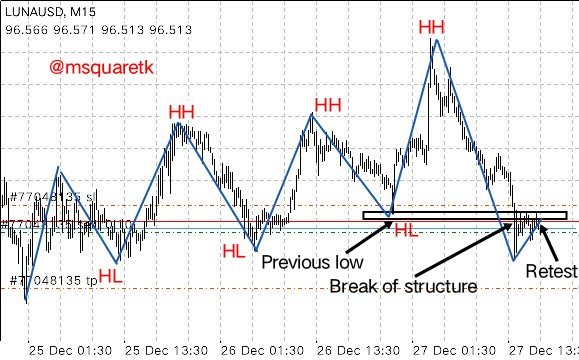
Screenshot from MT4 App
Exit Criteria
- Stop loss should be placed above the new resistance level or zone. That's SL can be placed immediately above the zone that got broken which is now the new resistance zone.
- Take profit is should be the double of the stop loss. That's it should be placed to have a risk reward of 1:2. However, if the nearest support zone is very close that it's lesser than 1:2, then that support zone should be used as the first target and 1:2 as the second target.
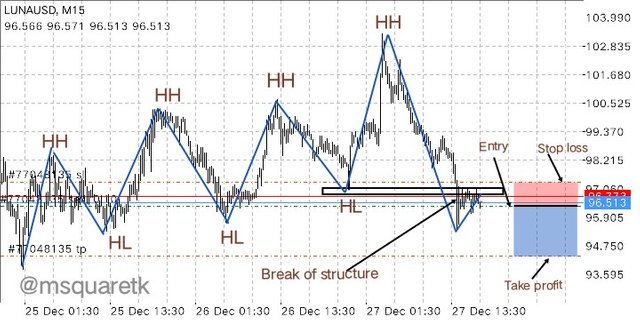
Screenshot from MT4 App
Calculating the Risk reward ratio to determine the stop loss and take profit
Now, for this, it depends on your trading capital and the amount or percentage you have decided to be risking. For this task, I have opened a demo account which is$10, 000. See the screenshot below.
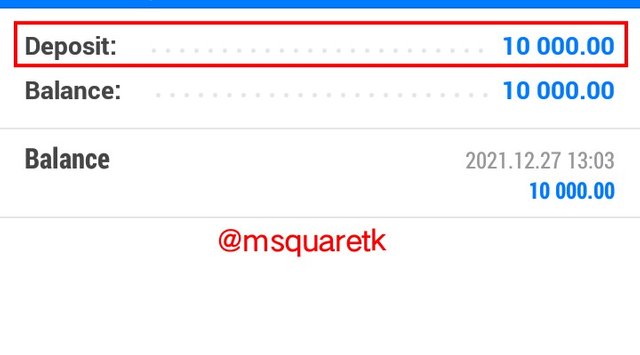
Screenshot from MT4 App
Now, for this account, I have decided to be risking just 1% of this account on each of the position I take in the market. This means that I will be risking $100 per trade
1/100 × $10, 000
0.01 × 10,000
= $100
Now, I placed a sell entry at 96.34 and stop loss was placed at 97.34 and take profit at 94.34. This means, I have about 100 pips for my trade to breathe. If the trade goes against me, I will lose 100 pips.
SL= 100pips
TP = 200 pips
Then, I used 0.1 lotsize.
Now, the formula for calculating the profit/loss is given below.
Profit/loss =lotsize × pips gained/lost ×10
Where 10 is constant.
Loss = 0.1 × 100 × 10
Loss = $100
Profit = 0.1 × 200 × 10
Profit = $200
Now, this means, if the trade goes against me, I will lose $100 and if it goes in my favor, I will gain $200.
Placing the stop loss and take profit
As soon as as I saw the price retested the broken level or zone, and a bearish candle form to the downside, I placed the entry at 96.34 and the stop loss above the new resistance zone at 97.34 and the take profit at 94.34 making a risk reward of 1:2.
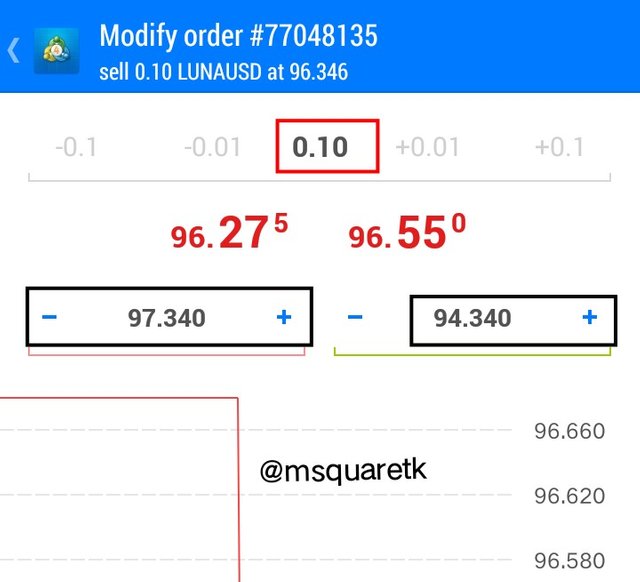
Screenshot from MT4 App
Then, some hours later after the execution, the trade hit the take profit. Below is the screenshot showing the profit of the LUNAUSD trade.
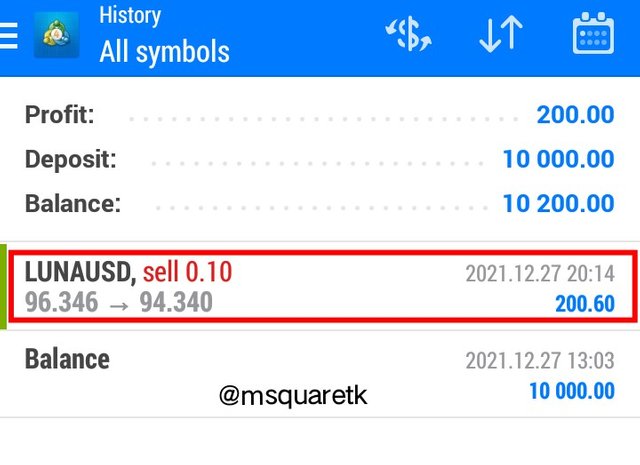
Screenshot from MT4 App
As we can see from that screenshot above, I have made a profit of $200. Remember we calculated that if the trade goes in my direction, I will make $200.
Trend Continuation Using market structure
SOLUSD
For the part B of the third question, the demo trade, I am going to be placing a buy demo trade on the chart of SOLUSD. I will discussing the entry and exit criteria for the trade, calculating the risk reward to determine the profit and loss for the trade and placing the stop loss and profit for the trade.
Entry Criteria
For trend continuation, we first determine which trend the market is. That's we must be sure if the market is trending up or down. In my case, I want to place a buy order, then I need to see the market creating higher highs and higher lows which was what SOLUSD was creating.
Then, since I wanted to join the trend, I would need to wait for price to pull back and create a low higher than the previous higher low.
Then, a buy entry should be placed when the bullish engulfing candlestick pattern form to the upside.
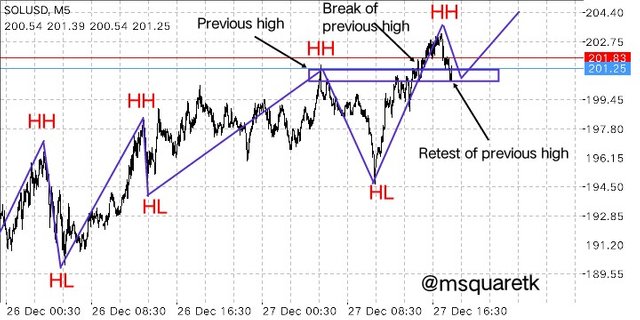
Screenshot from MT4 App
Exit criteria
Stop loss should be placed below the low created and take profit should be double the stop loss to give risk reward of 1:2
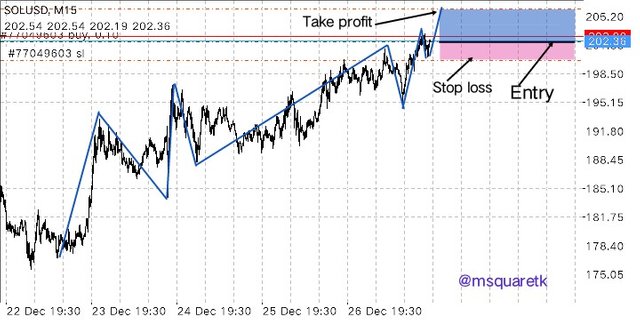
Screenshot from MT4 App
Calculating the Risk reward ratio to determine the stop loss and take profit
Now, for this, it depends on your trading capital and the amount or percentage you have decided to be risking. For this task, I will use the have demo account which is$10, 000 I used above for the first trade.

Screenshot from MT4 App
Now, for this account, I have decided to be risking just 2% of this account on each of the position I take in the market. This means that I will be risking $100 per trade
2/100 × $10, 000
0.02 × 10,000
= $200
Now, I placed a sell entry at 202.24 and stop loss was placed at 200.08 and take profit at 206.10. This means, I have about 200 pips for my trade to breathe. If the trade goes against me, I will lose 200 pips.
SL= 200pips
TP = 400 pips
Then, I used 0.1 lotsize.
Now, the formula for calculating the profit/loss is given below.
Profit/loss =lotsize × pips gained/lost ×10
Where 10 is constant.
Loss = 0.1 × 200 × 10
Loss = $200
Profit = 0.1 × 400 × 10
Profit = $400
Now, this means, if the trade goes against me, I will lose $200 and if it goes in my favor, I will gain $400, which is fair enough. By this, I will protect my account of $10, 000
Placing the stop loss and take profit
As soon as as I saw the price broke the new high, and coming back to retest it for continuation, I waited to see what price action will do. Then on getting to the zone, the price supported the level by forming an engulfing candle to the upside. Then I placed a buy entry at 202.23 and the stop loss beliw the low created at 200.08 and the take profit at 206.10 making a risk reward of 1:2.
.
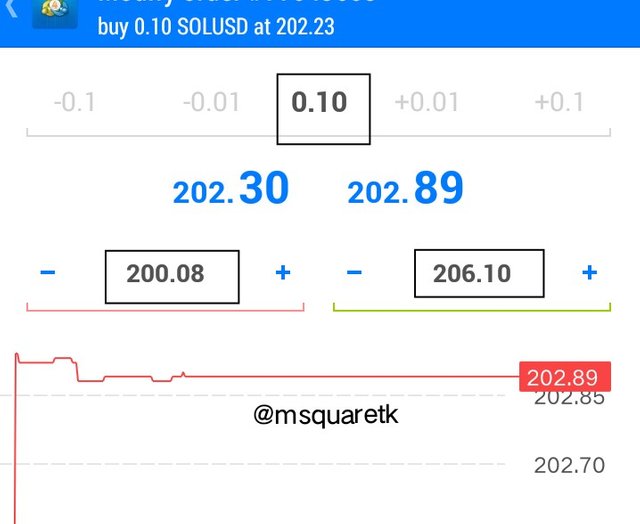
Screenshot from MT4 App
The trade is doing fine. It has entered profit already. Below is the screenshot showing the running trade.
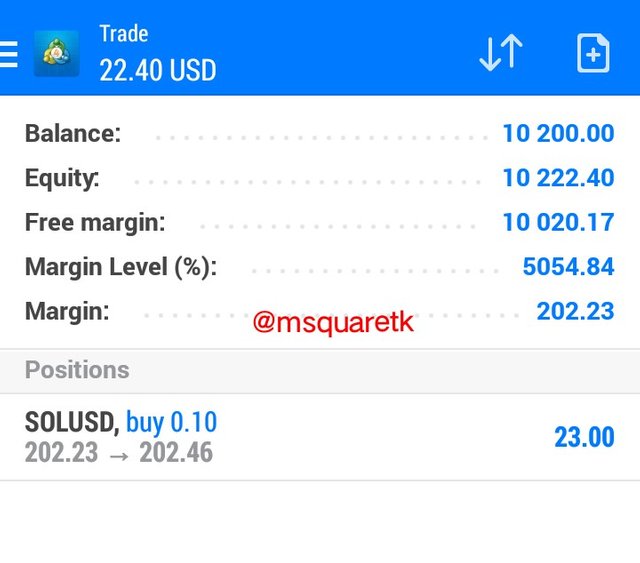
Screenshot from MT4 App

Conclusion

Risk management is one of the most essential aspects of trading. It involves prioritizing, planning and use of different tools to minimize loss and maximize profit. It's important that traders learn how to manage risk as early as possible so as to protect their trading capital. No body stays long in the market without having proper risk management. The importance of risk management can never be overemphasized. It helps minimize loss, protects trading capital, boosts trader's confidence etc.
Loss is inevitable in market. Cryptocurrency market is a very volatile market. Hence, crypto traders need the proper knowledge of risk management. There are some tools which help us manage risk. In this task, I have discussed three tools which are risk management tools.
Thanks to Professor @reminiscence01 for the teaching. I have learnt one or two things from the lecture.

NB: All screenshots are taken from my MT4 app.
CC: @reminiscence01
Written @msquaretk
Hello @msquaretk , I’m glad you participated in the 7th week Season 5 of the Beginner’s class at the Steemit Crypto Academy. Your grades in this task are as follows:
Recommendation / Feedback:
Thank you for participating in this homework task.
Thank you for the review Prof. @reminiscence01